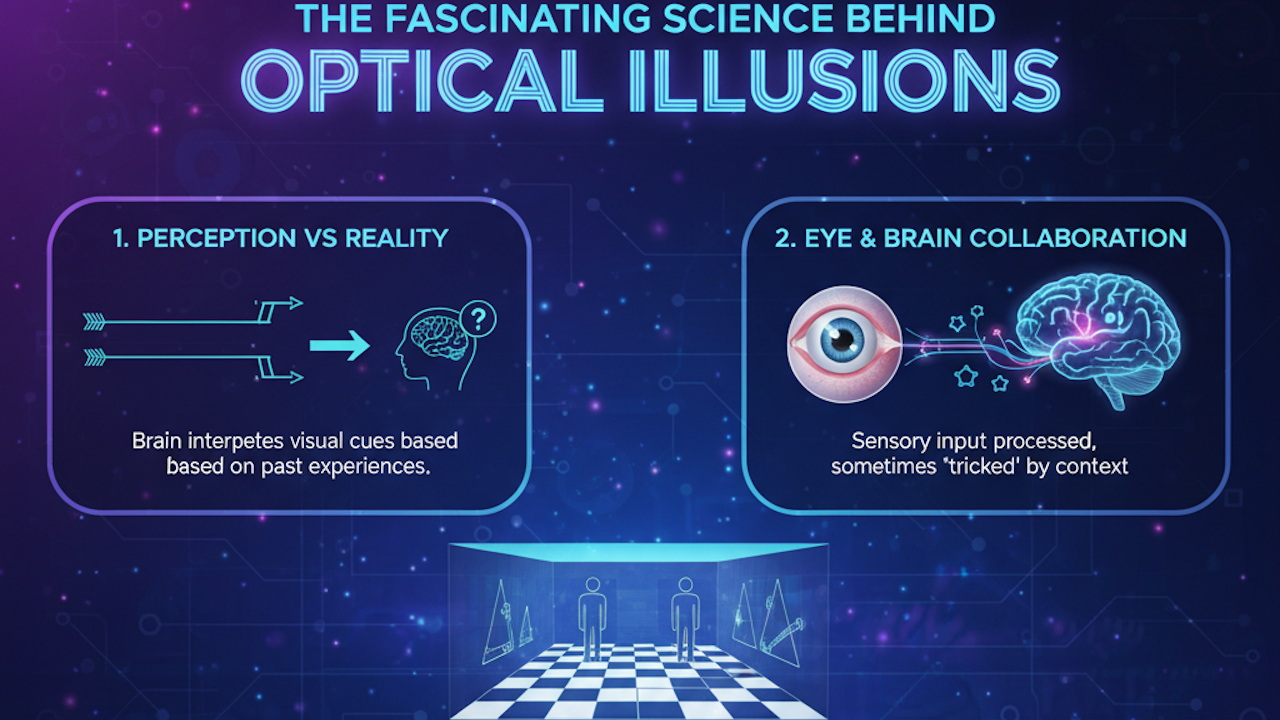Optical illusions have fascinated people for centuries. They appear in art, architecture, and everyday life, often leaving us puzzled about what our eyes and brain are doing. At their core, optical illusions reveal the complex relationship between perception and reality. They occur when the brain interprets visual information in a way that differs from the actual physical properties of the stimulus. By studying illusions, scientists gain valuable insights into how vision works, how the brain processes information, and why our perception can sometimes be deceived.
How Vision Works
To understand illusions, it helps to start with the basics of vision. Light enters the eye through the cornea and lens, which focus the light onto the retina at the back of the eye. The retina contains photoreceptor cells called rods and cones. Rods are sensitive to light and dark, while cones detect color and fine detail. Signals from these photoreceptors travel through the optic nerve to the brain, where the visual cortex in the occipital lobe processes them.
Vision is not a simple recording of the outside world. The brain must interpret raw data, fill in gaps, and resolve ambiguities. This process involves integrating sensory input with prior knowledge and context. Optical illusions exploit the shortcuts and assumptions that the brain uses, causing us to see something different from physical reality.
Types of Optical Illusions
Illusions can be grouped into several categories. One major type is literal illusions, where the image is constructed to trick the eye into seeing something that is not there. For example, drawings that appear to show impossible objects, like the famous Penrose triangle, fall into this category. Another type is physiological illusions, which occur because of how the eyes and brain respond to visual stimuli. Staring at bright colors or repetitive patterns can fatigue certain photoreceptors, producing afterimages or shimmering effects. Finally, cognitive illusions arise when the brain’s interpretation of a scene leads to a false conclusion. Classic examples include the Müller-Lyer illusion, where lines of equal length appear different because of the arrow-like shapes at their ends.
The Role of Context
Context plays a powerful role in how we interpret visual information. Our brain rarely processes objects in isolation; instead, it evaluates them in relation to surrounding shapes, patterns, and backgrounds. A famous demonstration of this is the checker shadow illusion by Edward Adelson. In this image, two squares on a checkerboard appear to be different shades of gray, yet they are exactly the same color. The brain compensates for the shadow cast by a cylinder in the scene, adjusting its perception of brightness. This shows how vision depends not just on the raw light hitting the eyes but also on the brain’s interpretation of context.
Depth and Motion Illusions
Another important category involves depth and motion. Our eyes rely on cues such as perspective, shading, and relative size to judge distance. When these cues are manipulated, the brain can be tricked into seeing depth where none exists. The Ames room, for example, uses distorted architecture to make people appear to grow or shrink as they move around the room. Motion illusions, on the other hand, exploit the brain’s tendency to interpret static patterns as moving. Images with repeating shapes, contrasting colors, and strategic placement of lines can create the impression of swirling or shifting even though the image is completely still.
Neuroscience of Illusions
Modern neuroscience has shed light on why illusions occur. Different parts of the brain specialize in different aspects of vision, such as detecting edges, recognizing faces, or processing motion. Optical illusions sometimes occur when these specialized regions send conflicting signals. For instance, the visual cortex contains neurons that respond to contrast and orientation. When presented with certain patterns, these neurons can be overstimulated or confused, leading to false perceptions. Illusions also highlight how much vision depends on prediction. The brain does not passively wait for information; it actively predicts what should be there based on experience. When the prediction is wrong, the result can be an illusion.
Evolutionary Perspective
From an evolutionary standpoint, illusions show that our visual system is optimized for survival rather than perfect accuracy. The brain uses shortcuts to quickly process information about the environment. These shortcuts usually serve us well, allowing us to recognize predators, find food, or navigate complex landscapes. However, in rare cases, they lead to misperceptions. For example, our sensitivity to edges and contrasts is crucial for detecting objects in nature, but the same sensitivity can be manipulated in laboratory settings to create striking illusions.
Applications of Illusion Research
Understanding optical illusions is not just a curiosity; it has practical applications. In medicine, illusions help scientists study disorders of perception, such as visual agnosia or neglect syndrome. In design and architecture, illusions are used to create certain effects, such as making spaces look larger or guiding the eye toward focal points. Artists like M. C. Escher have famously used illusions to challenge viewers’ sense of reality. Even in technology, illusion research informs areas like virtual reality, where creating convincing perceptions of depth and motion is essential.
Conclusion
Optical illusions remind us that what we see is not always what is there. They reveal the brain’s remarkable ability to interpret, predict, and sometimes misinterpret sensory input. By studying illusions, scientists gain insight into the fundamental workings of the visual system, from the level of photoreceptors in the eye to complex neural networks in the brain. More than just visual tricks, illusions demonstrate that perception is an active process shaped by context, experience, and evolutionary pressures. They highlight both the strengths and the limits of human vision, reminding us that reality is not only about what exists in the world but also about how our brains construct it.

